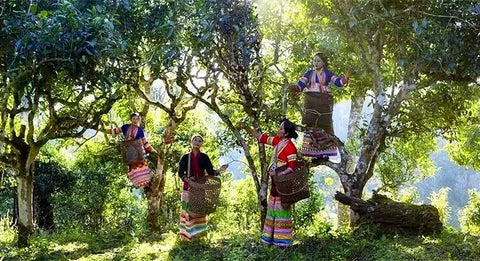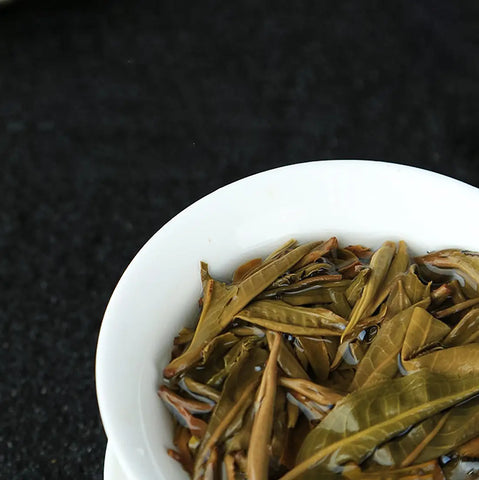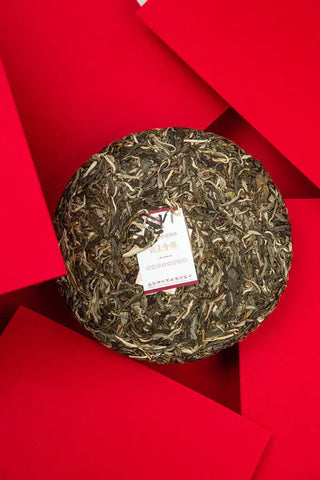How Is Pu Erh Tea Made
Shop our Pu Erh Tea collections!
Pu-erh tea, originating from Yunnan Province in China, is renowned for its distinct fermentation process and aging.
Definition and Origin
Pu-erh tea is a unique type of fermented and aged tea. Known for its deep, earthy flavor and dark color, it undergoes a special fermentation process after being oxidized. This sets it apart from other teas.
Bestsellers
Its origin traces back to Yunnan Province, where it has been cultivated for centuries. The tea leaves come from the large-leaf tea plant, Camellia sinensis var. assamica. Historically, it was traded along ancient routes, gaining popularity for its rich taste and health benefits.
Cultivating the Tea Plants
Cultivating Pu-Erh tea involves selecting the right terroir and cultivar, and mastering precise harvesting techniques.
Terroir and Cultivar Selection
Selecting the right terroir is vital. Pu-Erh tea thrives in specific regions, primarily Yunnan province in China. The soil, altitude, and climate significantly impact the quality of the tea. High elevations and humid conditions are ideal.
When it comes to cultivars, Camellia sinensis var. assamica is the preferred choice. This variety endures the specific growing conditions and produces the distinctive characteristics of Pu-Erh tea. Farmers choose this cultivar for its large leaves, which are necessary for the fermentation process.
Harvesting Techniques
Harvesting is a meticulous process that requires skill and timing. Leaves are picked during spring and autumn, when they are rich in nutrients. Tea leaves must be picked by hand to ensure the quality and integrity of each leaf.
The "two leaves and a bud" method is commonly used. This means plucking the top two leaves and the bud from each stem. These parts contain the right balance of flavors and nutrients. After harvesting, the leaves are quickly processed to prevent oxidation.
Initial Processing of Tea Leaves

The initial processing of Pu-erh tea leaves involves several crucial steps to ensure quality and unique flavor development. Each step, from withering to drying, plays a vital role in shaping the final product.
Withering
Withering begins immediately after harvesting. Freshly plucked tea leaves are spread out in a thin layer on bamboo trays or clean surfaces to reduce moisture content. This stage, which lasts several hours, allows the leaves to become pliable for further processing.
During withering, leaves are often kept in shaded areas to avoid direct sunlight. Careful monitoring ensures the leaves do not dry out completely, retaining just the right amount of moisture and flexibility needed for the next steps.
Pan Firing or Sha Qing
Pan firing, or Sha Qing, involves heating withered leaves in large woks or pans. This process halts oxidation by deactivating enzymes. Typically, leaves are briefly exposed to high temperatures around 200-250°C (392-482°F).
During pan firing, constant stirring is crucial. Heat must be evenly distributed to prevent burning. This step preserves the leaves’ green color and distinct aroma, preparing them for rolling and shaping.
Lao Ban Zhang
Rolling and Shaping
Rolling and shaping occur directly after pan firing. Leaves are manually or mechanically rolled to break their cell walls and release essential oils. This enhances the subsequent drying process and intensifies the tea's flavors and aromas.
This step also gives the leaves their initial shape, whether twisted, curled, or rolled into tight scrolls. Proper rolling impacts the tea's appearance and ensures a uniform drying process.
Drying
Drying is the final stage in the initial processing. Rolled leaves are spread out and either sun-dried or placed in large drying machines. Drying reduces moisture content to about 5-10%, essential for long-term storage and aging.
While sun drying may take several days, mechanical drying is faster and more controlled. By the end of this stage, leaves are crispy and ready for the next steps of fermentation and aging.
Post-Fermentation Process

Pu erh tea undergoes important steps after fermentation to develop its unique flavors and character. These processes include piling and aging which significantly influence the tea's taste, aroma, and quality.
Piling (Wet Piling or Wo Dui)
Piling, or Wo Dui, is a critical step in the processing of ripe Pu erh tea. The tea leaves are moistened and piled together to facilitate microbial fermentation. This process takes place in a controlled, humid environment where the temperature is monitored closely.
During piling, the leaves are turned periodically to ensure even fermentation. This step can last anywhere from several weeks to a few months depending on desired characteristics. The result is a deeper color and richer flavor profile. Piling helps in breaking down the compounds in the tea leaves, creating mellow, earthy characteristics.
Aging and Maturation
After piling, the tea must be aged to mature its flavors. This aging process can last for years, during which the tea undergoes slow oxidation and microbial activity. The environment where the tea is stored plays a significant role; it should be dry and well-ventilated to avoid mold growth.
As the tea ages, it develops complex flavors and a smoother texture. The changes during maturation enhance the depth and complexity of the tea, making well-aged Pu erh highly valued. Regular tasting can help in determining the ideal duration for aging. This process is essential for producing high-quality Pu erh tea.
Pressing Pu-erh into Cakes
To transform loose leaves into the characteristic cakes, methods like traditional stone molding and steam pressing are essential. Each technique contributes to subtle differences in the final product.
Traditional Stone Molding
Traditional stone molding uses ancient techniques. Leaves are placed into cloth bags and tightly packed. Pressure is applied using manually operated stone molds. This process compresses the leaves, giving the tea its iconic cake shape.
Craftsmen rely on experience to achieve the right pressure and shape. The tea cakes are then allowed to dry, which enhances the aging process. These manually pressed cakes often exhibit a unique texture and taste.
Stone molds offer a time-tested approach, emphasizing tradition and craftsmanship. Given their handmade nature, each cake may have slight variations, making them unique.
Steam Pressing Technique
Steam pressing involves modern technology. Leaves are steamed and softened before being placed in molds. Machines exert uniform pressure, forming consistent cakes. This technique is more efficient than traditional methods.
The use of steam ensures the leaves are pliable, preventing breakage. After being pressed, the cakes are cooled and dried, stabilizing their shape and flavor.
Steam pressing creates cakes with a uniform texture. It allows for large-scale production without compromising quality. This method is favored for its efficiency and consistency, producing high-quality Pu-erh tea.
Storage and Preservation

To maintain the quality of Pu-erh tea, proper storage is crucial. The tea ages and improves over time, so the way you store it can impact its flavor significantly.
Temperature: Keep Pu-erh tea in a stable, cool environment. Avoid extreme temperatures as they can spoil the tea.
Humidity: Ideal humidity levels are essential. Too much humidity can cause mold, while too little can dry out the tea leaves. Aim for a relative humidity around 60-70%.
Light: Store Pu-erh tea away from direct sunlight. Light can degrade the quality, leading to a loss of flavor and aroma.
Airflow: Ensure adequate airflow. Storing tea in a breathable container like a clay jar or porous bag allows it to age properly.
Containers: Use containers made of natural materials such as bamboo, wood, or clay. Avoid plastic or metal containers as they can impart unwanted flavors.
Location: A cool, dry cupboard or a specialized tea storage cabinet works best. Avoid kitchens and bathrooms where temperature and humidity levels can fluctuate widely.
Separation: Store Pu-erh tea separately from strongly scented items. Tea can absorb nearby odors, affecting its natural taste.
Keep these factors in mind to preserve the distinct flavors and aromas of your Pu-erh tea effectively. By following these guidelines, you can ensure that your tea matures gracefully over time.
Brewing Pu-erh Tea
Brewing Pu-erh tea involves selecting the right water, preparing your tea ware, and properly rinsing and steeping the leaves for the best flavor.
Choosing the Right Water
Water quality plays a crucial role in brewing Pu-erh tea. Use clean, filtered water with low mineral content. Spring water is an excellent choice if available. Avoid tap water, as it may contain chlorine and other impurities that can alter the tea’s flavor.
Heat the water to the appropriate temperature. For raw Pu-erh, aim for around 85-90°C (185-194°F). For ripe Pu-erh, the ideal temperature is slightly higher, around 95-100°C (203-212°F). Overheating can damage the delicate flavors, so use a thermometer if needed.
Preparing the Tea Ware
The right tea ware can enhance your Pu-erh tea experience. Traditional Chinese tea sets, particularly clay teapots known as Yixing, are ideal. Yixing clay enhances the tea’s flavors through repeated use. Porcelain or glass tea pots also work well if you prefer their aesthetic.
Warm your tea ware before use by rinsing it with hot water. This helps maintain the brewing temperature and prevents temperature shock. Ensuring the tea ware is clean and dry will also contribute to the tea's purity in taste.
Rinsing and Steeping
Rinsing the tea leaves is a common practice in brewing Pu-erh tea. This step removes impurities and prepares the leaves for optimal infusion. Pour hot water over the tea leaves and immediately discard the water. This quick rinse usually takes just a few seconds.
For steeping, use about 5 grams of Pu-erh tea per 150-200 ml of water. The first infusion should last around 20-30 seconds. Subsequent infusions can be slightly longer. Pu-erh tea leaves can be re-steeped multiple times, with each brew revealing new layers of flavor. Adjust steeping times based on your taste preference, making each session a unique experience.
← Older post Newer post →











